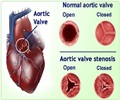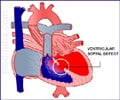The AHA /ACC guidelines for treating valvular heart disease have been updated to include scope for less invasive heart valve replacement in some patients.
- Organizations such as American Heart Association (AHA) and American College of Cardiology (ACC) periodically revise guidelines for heart disease treatment and prevention.
- These guidelines aim to help doctors improve efficacy of treatment and patient outcome with optimal use of resources.
- At present there is a paucity of research and information addressing the diagnosis and treatment of patients with valvular disease.
- The last published AHA /ACC guidelines in 2014 have been updated recently after publication of latest research data since then.
Suggested Guideline Updates For Aortic Valvular Heart Disease
The guideline update modifies present recommendations for open heart surgical aortic valve replacement and transaortic valve replacement (TAVR) based on the results of clinical studies conducted recently.- Surgical aortic valve replacement, for example, is recommended for persons with moderately symptomatic aortic stenosis and are considered low to intermediate risk for surgery i.e. they are deemed fit to undergo open heart surgery and unlikely to suffer any major complications due to the procedure.
- For patients with advanced aortic stenosis who have symptoms, such as shortness of breath (dyspnea) and fatigue, and considered intermediate to high risk for surgery, open heart surgery is more likely to be associated with complications and transaortic valve replacement (TAVR) is recommended as a safer and viable alternative.
"There have been significant developments in the treatment of patients with valve disease using open heart surgery to repair rather than replace leaky valves," said Rick Nishimura, M.D., a professor of medicine at Mayo Clinic and writing committee co-chair of the new guideline focused update. "For example, we are now able to replace abnormal valves using a catheter based approach, so that patients at higher risk of surgery can be treated less invasively."
Aortic Valvular Disease
The heart valves are 4 in number and normally allow blood flow from one heart chamber to the next only in the forward direction. They include the tricuspid valve, pulmonary valve, mitral or bicuspid valve and the aortic valve. The aortic valve regulates blood flow from the left ventricle into the aorta.Valvular diseases may be present since birth, be acquired due to infection or damaged following a heart attack. They are diagnosed when these damaged valves cause variations in the blood flow between the various heart chambers resulting in abnormal sounds (murmurs) heard over the chest on auscultation (hearing chest sounds using a stethoscope).
The two major types of valvular disease include ‘stenosis’ and ‘regurgitation’. Stenosis occurs when the valvular orifice is narrowed thus reducing blood flow from one chamber to the next. In an ‘incompetent’ valve, the valve permits backflow of blood into the chamber (in aortic valve incompetence, blood leaks back from aorta into the left ventricle). This phenomenon is also referred to as regurgitation.
- The need for antibiotics prior to a dental procedure in certain patients; and
- Increasing the age range for choosing tissue valve replacement.
Antibiotics before Dental Treatment
Traditionally antibiotics have been given to reduce risk of infective endocarditis, a potentially life-threatening condition that occurs due to infection of the heart valves. The bacteria causing infective endocarditis are released into the bloodstream during dental procedures. As per the latest guidelines, they are recommended in the following situations
- People who have had previous valve replacement surgery
- People with previous history of infection of the heart valve
- Patients with certain types of congenital heart disease and were born with abnormal valves
Increasing the Age-Range for Valve Replacement Surgery
In patients undergoing aortic or mitral valve replacement, the age range was increased from the existing 60 to 70 years of age to 50 to 70 years of age for the choice of either a mechanical or tissue valve.- Mechanical valves last longer than tissue valves but may require taking blood thinners for life, and were previously recommended for patients younger than 60 years old.
- The availability of newer tissue valves that last longer than the earlier generation of tissue valves, without the need for replacement as often, give patients between the ages of 50 and 60 more options, Nishimura said.
Reference:
- Infective Endocarditis - (http://www.heart.org/HEARTORG/Conditions/CongenitalHeartDefects/TheImpactofCongenitalHeartDefects/Infective-Endocarditis_UCM_307108_Article.jsp#.WMgJW2997IV)
















